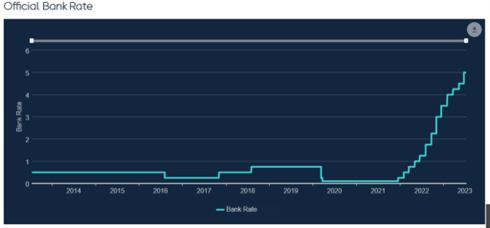According to the Daily Telegraph, around 225,000 landlords will be in a loss making situation following the latest jump in refinancing costs.
It is estimated that these landlords will be in the red when they come to refinance as mortgage rates are climbing towards upwards of 7 per cent for the first time in 25 years.
Moneyfact’s figures show that the average two-year buy-to-let mortgage deal was at 6.69 per cent last week, while five-year deals could be had for around 6.52pc.
The Bank of England and inflation
The Bank of England’s Monetary Policy Committee (MPC) has a brief from Government to set monetary policy to meet the 2% inflation target, and to meet it in a way that helps to sustain growth and employment.
At the last meeting on 21 June 2023, the MPC voted by a majority of 7–2 to increase Bank Rate by 0.5 percentage points, to 5%. It is expected the next meeting on 3 August 2023 will see a further rise.

[Source: Bank of England]
If inflation continues to increase, the bank rate is likely to continue rising, as does the price of everything else, including mortgage rates. Wage and price demands fuel more inflation and so the vicious circle continues.
The Bank’s aim is to bring inflation under control using one of the limited number of tools at its disposal, interest rates. The problem for mortgage holders it that the effects of this falls directly on them.
In the financial world, mortgage rates depend on the demand for mortgage backed bonds. Inflation reduces the demand for these mortgage-backed securities or bonds. As demand drops, the prices of mortgage-backed securities fall. That results in higher interest rates for all mortgage types.
Mortgage-backed securities are securities formed by pooling mortgages together. The investor who buys a mortgage-backed security is essentially lending money to home buyers. During the subprime mortgage meltdown of 2007-2008, it became apparent to everyone that a mortgage-backed security is only as sound as the mortgages that are bundled in it.
Forecasters are now predicting that in order to kill off inflation the Bank of England is set to raise the base rate again at future meetings, eventually to a 25-year high of 6.25pc by early in the new year, which will almost certainly force mortgage lenders to increase their mortgage rates above 7 per cent.
Home ownership
More people now own their homes outright than have a mortgage or are renting. The latest available figures show that around 33 per cent of dwellings were owned outright in England in 2021, that’s up from just over 30 per cent in 2011.
Another 28 per cent of properties were owned with a mortgage or loan, that’s down four percentage points on a decade earlier, and 20 per cent are privately rented, that figure is up 3.7 per cent according to the Office for National Statistics.
Homes in the social rented sector were around 17 per cent while of those it is estimated that 226,930 buy-to-let homes across the UK (11pc of all mortgaged rentals) are likely to be unprofitable due to the rise in mortgage rates.
According to Money.co.uk it is estimated that around 60% of all landlords fund at least part of their portfolio through a buy-to-let mortgage, while 41 per cent own outright, 35 per cent hold all of their properties on a mortgage and 24 per cent hold some of their portfolio on a mortgage. It has been estimated that around 60 per cent of landlords own a single property, while over half of buy-to-let landlords own more than one.

[Source: ONS]
According to Uswitch the UK buy-to-let market had:
- £8.5 billion worth of buy-to-let properties purchased by UK landlords in Q1 2022.
- In 2022, more than 211,000 buy-to-let mortgages were approved by UK lenders, and occupied 13.6% of total mortgage lending for the year.
- Consumer buy-to-let mortgages in 2022 are valued at approximately £955 billion, with buy-to-let mortgage advances worth £41.8 billion.
- There are currently around 2.74 million landlords in the UK, with more than two-thirds (68%) over the age of 55.
- Milton Keynes has seen the greatest growth in buy-to-let properties with a 667% increase between 2021-22.
- The average UK landlord has eight properties in their portfolio, generating a gross annual rental income of around £61,000 per property.
Financial Stability
A recent report buy the Bank of England, The Financial Stability Report July 2023 says that the pressure put on buy-to-let mortgage borrowers by increases in mortgage interest payments would lead to (1) them either selling up, further adding to the rental housing shortage, and putting downward pressure on house prices, or (2) alternatively, they may be asking their tenants to pay more in rent.
The overall number of mortgages in arrears, says the report, increased slightly over the first quarter of 2023 but has remained low by historical standards, though “It will take time for the full impact of higher interest rates to come through.”
Head of research at property agents Hamptons, Aneisha Beveridge, told The Daily telegraph:
“We know that nearly 70pc of landlords in England own a home with a mortgage. That’s a much higher proportion than among owner-occupiers. So landlords are more at risk to the new kind of higher rate environment than the average household.
“The highest-leveraged landlords who bought in the last couple of years are most at risk. They are the ones who have taken equity out of their properties or bought a new buy-to-let in the last couple of years,” Ms Beveridge said.
“We haven’t seen as much of an acceleration in landlords selling off as we expected, as rates have risen over the last six, seven, eight months.”
This has led to many property investors selling up in the more expensive areas such as in London and the South-east, where prices are high and yields low, for other parts of the UK where buy-to-lets can be picked up for much lower prices, and consequently returns are higher. That’s according to Kevin Roberts of Legal & General who told the daily Telegraph:
“They are moving their portfolios to where the yield is. There are still better yields in the Northwest or the north of England or other parts of the UK. Airbnb and holiday homes are still massively searched for on our tools”
An additional factor having an impact on the rental market at the moment is the Government’s plan to abolish the shorthold tenancy and Section 21 evictions, for some landlords this is a worry and has been the last straw.
These statistics shown above hold out a rather dismal prospect for tenants looking for accommodation. Rents are higher than ever for new tenancies, and these tenancies are hard to find when some landlords are offloading their buy-to-let portfolios. All the property portals, including Zoopla, Rightmove and Spare Room are reporting substantial excess demand over rental supply.




